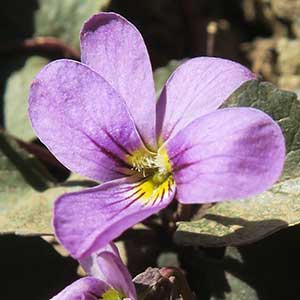Viola flettii
Viola sheltonii
Flett's violet, Olympic violet, rock violet
cut-leaf violet, fan violet, Shelton's violet
1–3, ascending to erect, mostly glabrous, on caudex from fleshy rhizome.
1–3, prostrate, decumbent, or erect, glabrous or sparsely puberulent, from short, often vertical, deep-seated or usually shallow, subligneous rhizome.
basal and cauline;
basal: 1–3;
stipules linear-lanceolate, margins entire or with glandular processes, apex acuminate;
petiole 1.5–9.7 cm, mostly glabrous;
blade purple-tinted and –veined, broadly reniform to ovate, 0.9–2.4 × 1.2–4 cm, base cordate, margins finely crenate-serrate, eciliate, apex acute to obtuse, surfaces glabrous or sparsely pubescent along veins adaxially;
cauline similar to basal except: stipules ovate to lanceolate, margins entire or shallowly laciniate;
petiole 0.7–5.9 cm, usually glabrous;
blade 0.8–2.1 × 1.2–3.1 cm.
basal and cauline;
basal: 1–3, palmately compound, leaflets 3;
stipules lanceolate-ovate, margins laciniate with gland-tipped projections, apex acute to acuminate;
petiole 8.6–21 cm, glabrous or sparsely puberulent;
blade reniform or ovate to ± orbiculate, 2–7 × 2–11 cm, coriaceous, base tapered, each leaflet cleft or dissected into 3 ± obovate lobes, each lobe further divided into 2–3 oblanceolate, pandurate, spatulate, oblong, lanceolate, or elliptic, lobes 2–10 mm wide, margins entire, ciliate or eciliate, apex acute to obtuse, mucronulate, surfaces glabrous or sparsely puberulent;
cauline similar to basal except: stipules ovate to lanceolate, margin projections gland-tipped or eglandular, apex long-acuminate;
petiole 5.5–12 cm;
blade 1.2–6.3 × 1.2–10.5 cm.
1.8–7.1 cm, usually glabrous.
5–19 cm, glabrous or sparsely puberulent.
sepals lanceolate, margins eciliate, auricles 0.5–1.5 mm;
petals soft reddish violet on both surfaces, all with yellow area basally, lower 3 dark violet-veined, lateral 2 bearded, lowest with white around yellow area, 10–15 mm, spur yellow, gibbous, 0.5–2 mm;
style head bearded; cleistogamous flowers axillary.
sepals lanceolate, margins ciliate or eciliate, auricles 0.5–1 mm;
petals deep lemon-yellow adaxially, upper 2 dark brown to brownish purple abaxially, lower 3 and sometimes upper 2 brownish purple-veined, lateral 2 bearded or beardless, lowest 7–18 mm, spur yellowish with brownish purple specks, gibbous, 1–2 mm;
style head bearded; cleistogamous flowers axillary.
± spherical, 5–9 mm, glabrous.
oblong to ovoid, 6–8 mm, glabrous or puberulent.
dark brown to brownish purple, 2.5–3 mm.
brownish, shiny, ca. 2.5 mm.
= 12.
Viola flettii
Viola sheltonii
Viola flettii is endemic to the Olympic Mountains of northwestern Washington. C. S. McCreary (2005) noted that although morphologically and ecologically distinct, V. cuneata, V. flettii, and V. ocellata are closely related.
(Discussion copyrighted by Flora of North America; reprinted with permission.)
The cleistogamous flowers of Viola sheltonii are borne on long, prostrate peduncles usually buried in duff around the plant. Mature cleistogamous capsules are usually hidden and the dehisced seeds remain close to the parent plant. Some populations of V. sheltonii produce only cleistogamous flowers (D. Klaber 1976).
(Discussion copyrighted by Flora of North America; reprinted with permission.)


